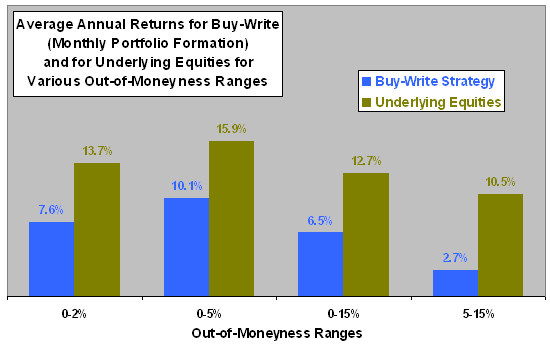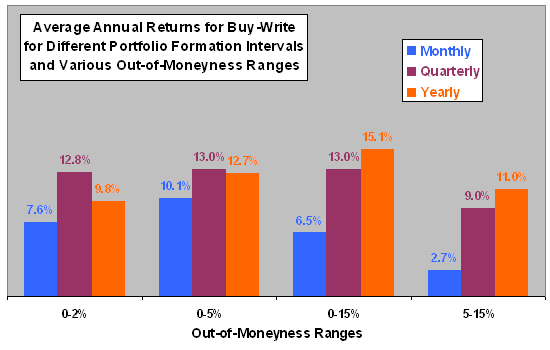Do buy-write strategies, wherein investors buy stocks and simultaneously sell matched out-of-money call options, generally outperform their underlying stocks? In other words, do option premiums more than compensate for any sacrifice of capital gains? In their January 2010 paper entitled “The Efficiency of the Buy-Write Strategy: Evidence from Australia”, Tafadzwa Mugwagwa, Vikash Ramiah and Tony Naughton examine the performances of buy-write strategies on the Australian Stock Exchange for portfolios formed monthly, quarterly and yearly at different levels of call option out-of-the-moneyness. They test the profitability of buy-write strategies during weak and strong markets. They measure the effects on buy-write returns of underlying stock liquidity (turnover ratio), dividend yield, firm size, book-to-market ratio, earnings per share and price-earnings ratio. Using prices, firm fundamentals and out-of-the-money call option prices (actual and modeled) for 179 stocks over the period January 1995 through October 2006, they conclude that:
- Underlying stocks consistently outperform buy-write strategies (see the first chart below). For instance, a buy-write portfolio formed monthly with options 0% to 2% out-of-the-money generates an average annual return of 7.6%, compared to 13.7% for the the underlying stocks.
- Buy-write strategies do not realize significantly lower volatilities than underlying stocks for 10 of 12 portfolios studied.
- Buy-write strategies do not significantly outperform underlying stocks during weak market conditions (negative past returns and high volatility). During strong market conditions, buy-write strategies underperform underlying stocks.
- Buy-write strategy profitability tends to increase with option out-of-the-moneyness to a point, but then decrease with out-of-the-moneyness when deep out of money.
- Perhaps due to an Australian preference for options with a maturity of about three months, quarterly buy-write formation intervals work best. Monthly formation intervals are worst (see the second chart below).
- Screening for high earnings per share, small size, high dividend yield, low trailing and forward price-earnings ratio and high book-to-market ratio have similar positive impacts on both buy-write strategies and underlying stocks.
The following chart, constructed from data in the paper, shows the average annual returns for buy-write portfolios formed monthly at various levels of out-of-the-moneyness over the period January 1995 through October 2006, along with returns for the underlying stocks. The buy-write portfolios underperform. The standard deviations of annual returns for underlying equity portfolios are lower than those for corresponding buy-write portfolios for three of four out-of-the-moneyness ranges.

The next chart, also constructed from data in the paper, shows the average annual returns for buy-write strategies based on monthly, quarterly and yearly formation intervals at various levels of out-of-the-moneyness over the period January 1995 through October 2006. Quarterly and yearly formation intervals consistently beat a monthly formation interval.

In summary, evidence indicates that buy-write strategies generally underperform their underlying stocks in Australia.
This study involves assumptions and modeling that may limit applicability to actual trading. Also, there may be country peculiarities, such as: “Given that Australian options traders deal with quarterly options more regularly, we find that the most favourable rebalancing period for [buy-write strategies] in Australia is quarterly, as opposed to the monthly preference of the US.”